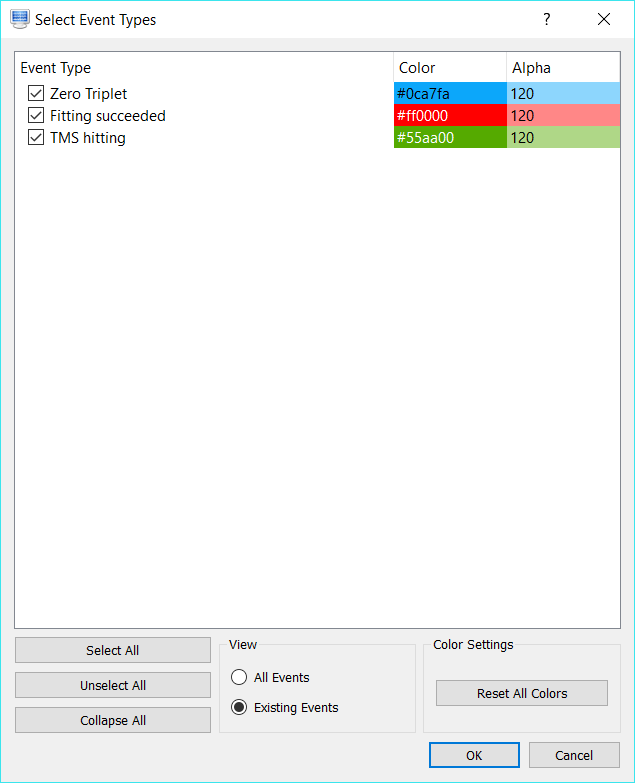SigViewer is a viewing application for biosignals such as EEG or MEG time series. In addition to viewing raw data, SigViewer can also create, edit, and display event information (such as annotations or artifact selections).
- SigViewer 0.6.4 (Windows)
- SigViewer 0.6.4 (macOS)
- SigViewer 0.6.4 (Linux) (Arch, Debian, Ubuntu)
- SigViewer 0.6.4 (Source)
SigViewer requires a standard-compliant C++11 build toolchain, for example recent versions of GCC or Clang. Other compilers such as MSVC might work, but are not tested. Furthermore, SigViewer depends on Qt. Current SigViewer builds use Qt 5.12 (previous or future versions are not guaranteed to work).
SigViewer also depends on libbiosig and libxdf. There are two options to get these external dependencies for your platform:
- Build these dependencies yourself (see separate descriptions below).
- Use our pre-built binaries. The corresponding archive contains binary versions of libbiosig and libxdf and must be extracted into SigViewer’s source folder (which we denote as
$sigviewer).
Building SigViewer on Windows is currently not supported. We provide binaries created with the MXE cross compilation environment.
SigViewer requires Mac OS X (now renamed to macOS) 10.9 or later. First, install XCode from the App Store. Next, download and install Qt 5.12.3 for macOS or install Qt via Homebrew by running brew install qt in a terminal. Make sure that qmake is available on the path if you want to build SigViewer in a terminal. Alternatively, you can build SigViewer with Qt Creator (please refer to the description for building SigViewer on Windows).
- Download and unzip the SigViewer source.
- Provide all external dependencies:
- Either download the external archive and extract it inside
$sigviewer. - Or copy the necessary files from libbiosig and libxdf builds to the corresponding folders as detailed in the build descriptions for libbiosig and libxdf below.
- Either download the external archive and extract it inside
- In a terminal, change to
$sigviewerand runqmake. - Run
make(or if you want to use more cores to build in parallel, runmake -j4if you want to use four cores). The SigViewer binary is built in thebin/releasefolder. - To create a stand-alone version of SigViewer, open a terminal, change into
$sigviewer/bin/releaseand runmacdeployqt sigviewer.app -dmg. This creates a disk image with the app, which can then be dragged to the Applications folder.
Install the GNU build toolchain and Qt 5 with your native package manager. You can either build on the command line or with Qt Creator (which you then need to install).
- Download and unzip the SigViewer source.
- Provide all external dependencies:
- Either download the external archive and extract it inside
$sigviewer. - Or copy the necessary files from libbiosig and libxdf builds to the corresponding folders as detailed in the build descriptions for libbiosig and libxdf below.
- Either download the external archive and extract it inside
- In a terminal, change to
$sigviewerand runqmake. - Run
make(or if you want to use more cores to build in parallel, runmake -j 4if you want to use four cores). The SigViewer binary is built in thebin/releasefolder.
Building libbiosig on Windows is currently not supported.
To build libxdf from source, follow these steps:
- Download and unzip the libxdf source (SigViewer 0.6.4 uses libxdf 0.99).
- On the command line, run
qmakefollowed bymingw32-make(or build the project with Qt Creator) (instead ofqmake, you can also runcmake .). - Copy
xdf.hinto$sigviewer/external/includeandlibxdf.ato$sigviewer/external/lib.
To build libbiosig from source, follow these steps:
- Download and unzip BioSig for C/C++ into
$libbiosig(SigViewer 0.6.4 uses libbiosig 1.9.4). - Change line 156 of
Makefile.intoCFLAGS += -mmacosx-version-min=10.9(replace10.13with10.9). - In a terminal, change to
$libbiosigand run./configure. - Run
make. - Copy
biosig.h,biosig-dev.h,gdftime.h, andphysicalunits.hto$sigviewer/external/includeandlibbiosig.ato$sigviewer/external/lib.
To build libxdf from source, follow these steps:
- Download and unzip the libxdf source to
$libxdf(SigViewer 0.6.4 uses libxdf 0.99). - In a terminal, change to
$libxdfand runqmakefollowed bymake(instead ofqmake, you can also runcmake .). - Copy
xdf.hinto$sigviewer/external/includeandlibxdf.ato$sigviewer/external/lib.
To build libbiosig from source, follow these steps:
- Download and unzip BioSig for C/C++ into
$libbiosig(SigViewer 0.6.4 uses libbiosig 1.9.4). - In a terminal, change to
$libbiosigand run./configure. - Run
make. - Copy
biosig.h,biosig-dev.h,gdftime.h, andphysicalunits.hto$sigviewer/external/includeandlibbiosig.ato$sigviewer/external/lib.
To build libxdf from source, follow these steps:
- Download and unzip the libxdf source to
$libxdf(SigViewer 0.6.4 uses libxdf 0.99). - In a terminal, change to
$libxdfand runqmakefollowed bymake(instead ofqmake, you can also runcmake .). - Copy
xdf.hinto$sigviewer/external/includeandlibxdf.ato$sigviewer/external/lib.










